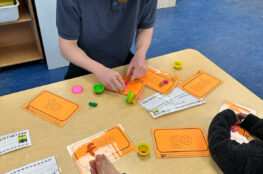Shelly Moore on EA’s
I am a teacher with zero experience, well, not zero, but compared to teachers who have spent 30 years teaching students, what I have done is but a drop in a vast sea of knowledge and experience. While this is indisputable, I think I need to form a manageable system of beliefs as I prepare to enter the workforce despite my lack of experience. A video that has been weighing heavily on my conscience is Shelly Moore’s “People Are Not Tools.” This video got me thinking about my relationship with EAs when I become a teacher. In my first practicum, I loved my Mentor teacher; she really encouraged me to take risks and be creative with my teaching, but someone who was equally as impactful in my experience was the classroom EA. The EA, Mrs. B, was full time in out class, and was part of the every day classroom experience, she greeted students in the morning, checked up on how they were feeling, helped them open their snacks at lunch, and helped with zippers and shoes at the end of the day, a skill I need to work on seriously (It’s hard because its backwards.) She was a crucial part of the classroom and gave me rock-solid advice, proving invaluable to my learning experience. That brings me to the point of this journal: What is the most efficient way to collaborate and work in tandem with EAs to maximize learning in the classroom? Some fantastic EAs made my schooling a beautiful experience. Still, at other times, the same EAs in a different classroom would only work with one student, and the teacher would spend zero time with the student who was with the EA. Now, as previously mentioned, I know very little, but intuition is something I believe to be true. In the latter case scenario, I believe it is an inefficient use of a fantastic classroom resource and undervaluing people who can help in a plethora of ways. Connecting to Shelly Moore’s idea, I think that when teachers enable (I cannot find the word that makes sense here, hopefully this does) EAs to work with one student, that seems to fall under the tool category. From what I experienced, it allowed the teacher to not spend any time with students who needed EA support and spend their time working with other students. This use of EAs does not seem effective, and this was frowned upon in last semester’s class. Now I do not want to label and diminish the work that these EAs are doing, anyone who knows anything knows how valuable (and underpaid) EAs are, and to use them as a tool for one student minimizes their value in the classroom as a whole. To cap off this “rant,” I want to make sure that I am not trying to critique or ostracize teachers or EAs, and if this comes off this way, please let me know. Still, I think as educators, it is our responsibility to maximize the learning capabilities of our classroom, and working effectively with an EA is an essential resource that teachers can use. As I continue to grow and learn, I hope to gather these skills and learn from those whose knowledge dwarfs mine to build these tools and become the educator I want to be.
BC Curriculum
The BC curriculum emphasizes the importance of inclusive education and the belief that all students have the potential to succeed when provided with the right supports and opportunities. This aligns closely with my growing understanding of the role of Educational Assistants (EAs) in the classroom. The curriculum’s core competencies, such as communication, collaboration, and critical thinking, are not just for students; they are equally essential for educators and support staff working together to create an inclusive learning environment. By fostering a collaborative relationship with EAs like in my first practicum, I can better address the diverse needs of my students, ensuring that every learner feels valued and supported. The BC curriculum also highlights the importance of personalized learning, which reinforces the idea that EAs should not be limited to working with a single student but should instead be integrated into the broader classroom dynamic to support all learners. This approach not only maximizes the potential of EAs as valuable team members but also ensures that teachers, like myself, can effectively differentiate instruction and meet the varied needs of our students. As I continue to develop my teaching philosophy, I am committed to aligning my practices with the principles of the BC curriculum, ensuring that collaboration with EAs is purposeful, inclusive, and student-centered.
Teacher Competencies
The obvious connection for this journal is #8, develop positive and supportive connections with students and colleagues, building professional learning networks. I chose this over #7, as this journal encompasses a broader spectrum than collegial connection. Relationships with EA are more than just peer-to-peer; to truly maximize learning, I believe that the entire classroom ecosystem needs to be considered. To make this work, connection is the key; creating relationships with parents, students, and EAs is a must. How do you work well with an EA if you don’t know how they like to do things and vice versa? How are you going to circulate and connect with kids if you only know them in an academic setting at a surface level? The answer is you can’t. Working with EAs effectively requires connection, and a lot of it; it takes time, passion, and no amount of classroom management or experience can overcome a deficit in this area. Connection reigns supreme, and I put this concept at the top of my list going into my practicum and hold this value deep in my heart.



